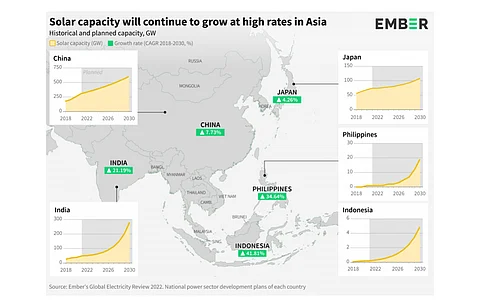

In the coming years, Asia's 5 biggest economies namely China, Japan, Indonesia, India and the Philippines are expected to experience exponential solar power growth with the fastest growth anticipated in Indonesia and the Philippines, says climate and energy think tank Ember.
Analysts see these countries growing their solar capacity with an average of 22% annually 'positioning the region to become a global hub of solar power'. Solar is well positioned to become a core part of Asia's energy future, they add, as the region invests in energy storage and policy support to manage grid stabilization.
Of the 1.2 TW wind and solar power capacity that China targets to achieve by 2030, Ember estimates at least 600 GW to come from solar alone since it accounted for a 50% share of capacity additions on average between 2012 and 2021. Ember's Asia Senior Electricity Policy Analyst Dr Muyi Yang added, "We believe this to be a cautious estimate, as some analysts estimate that China could reach its 1,200 GW wind and solar goals as soon as 2026."
Indonesia targets to add 4.68 GW solar by 2030, up from the current level of only 180 MW. Solar electricity generation currently accounts for less than 0.2% share in the country's total electricity mix (see Indonesia: Unambitious Solar Plans).
Southeast Asian Energy Analyst at the Centre for Research on Energy and Clean Air (CREA) Isabella Suarez pointed out that Indonesia's 5 GW target is 'far below what the country is capable of'. Referring to a September 2021 Indonesian Ministry of Energy and Mineral Resources' assessment of the country's renewable energy potential pegging it at 400 GW, 50% or 200 GW of which is solar energy, Ember says the country should prioritize solar as the main energy source in its next power development plan.
By 2030, the Philippines has an official aim to install 18 GW of solar, which would be a growth 12 times more from 1.37 GW installed now. According to Ember, the country is on track to achieve the target as all of 18 GW is 'already accounted for in the proposed project pipeline'.
Solar Philippines alone wants to exceed 10 GW by 2025 (see SPNEC Submits Offers To Contract 10 GW Solar).
One of the growing global solar markets, India's objective is to grow its solar PV capacity to 300 GW cumulatively by 2030 which would make it one of the world's largest solar fleets. Even as the government push is working coupled with increased interest of the private sector, analysts see investments in grid stabilization and energy market reform as a key challenge to manage this expansion.
At the same time, India needs a 'comprehensive policy reform' to benefit from rooftop solar expansion.
"This cost element will be critical to realizing India's solar potential in the short term. We'd hope the recent volatility in energy prices leads to a redoubled effort to improve the quality of the country's grid and increase utility scale solar power generation," added Energy Finance Analyst with the Institute for Energy Economics and Financial Analysis (IEEFA), Norman Waite.
Ember expects solar power capacity in Japan exceeding a cumulative 100 GW by 2030, growing from over 50 GW at the end of 2018 with a compounded annual growth rate (CAGR) of 4.26%.
